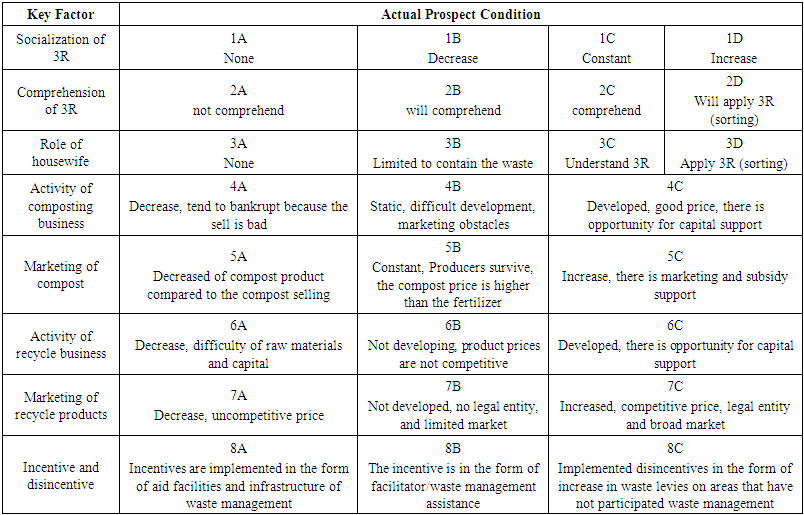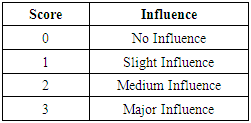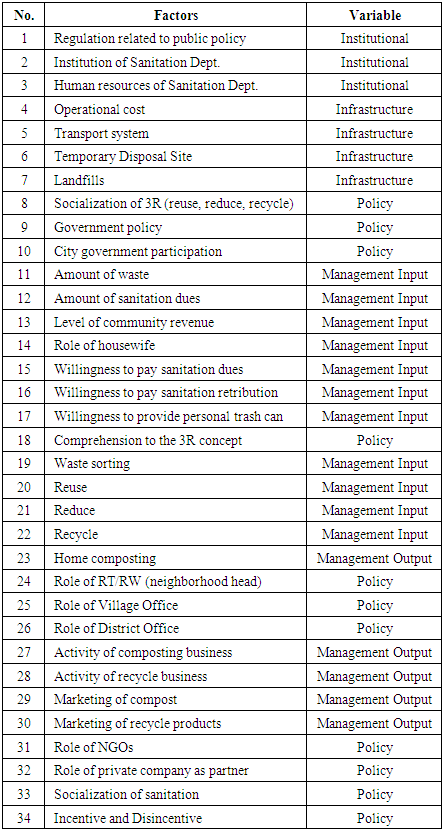-
Paper Information
- Paper Submission
-
Journal Information
- About This Journal
- Editorial Board
- Current Issue
- Archive
- Author Guidelines
- Contact Us
Resources and Environment
p-ISSN: 2163-2618 e-ISSN: 2163-2634
2017; 7(4): 87-93
doi:10.5923/j.re.20170704.01

Community-based Management of Waste in Settlements- Designated Area, Ujung Pandang District, Makassar
Hasir Tjenne1, Soemarno2, Bagyo Yanuwiadi2, Iskandar B. P.3
1Doctoral Program of Environmental Sciences, University of Brawijaya, Malang, Indonesia
2Graduate School, University of Brawijaya, Malang, Indonesia
3Islamic University of Indonesia, Makassar, Indonesia
Correspondence to: Bagyo Yanuwiadi, Graduate School, University of Brawijaya, Malang, Indonesia.
| Email: |  |
Copyright © 2017 Scientific & Academic Publishing. All Rights Reserved.
This work is licensed under the Creative Commons Attribution International License (CC BY).
http://creativecommons.org/licenses/by/4.0/

Tamangapa Landfill has started to show limitations in accommodating the waste volume from Makassar City. The communities have implemented 3R program. The aim of this study is to analyse the prospects and potential of community-based waste management that has been implemented in Makassar, especially waste from settlements designated area. The study was conducted in settlement area in Pisang Utara Village and Baru Village of Ujung Pandang District. Primary data were collected by questionnaire, in-depth interview and focus group discussion. Secondary data were collected from file and documents from related institution or parties. The prospective analysis is used to prepare for strategic action and see if changes are needed in the future. The results of the assessment resulted in three scenarios. The three scenarios are fairly optimistic (29.50%), the condition remains as it is / Static (22.50%), and optimistic (23.50%). Fairly Optimistic means there is synergy of institution and community participation; Static/Constant means synergy of institution and community participation in current condition, while Optimistic means synergy of institution and community participation is fairly high. The selected scenario based on FGD assessment is the fairly optimistic scenario, which recommended as the highest possibility for the implementation.
Keywords: Community-based waste management, Settlement-designated area, Prospective analysis, Strategy scenario
Cite this paper: Hasir Tjenne, Soemarno, Bagyo Yanuwiadi, Iskandar B. P., Community-based Management of Waste in Settlements- Designated Area, Ujung Pandang District, Makassar, Resources and Environment, Vol. 7 No. 4, 2017, pp. 87-93. doi: 10.5923/j.re.20170704.01.
Article Outline
1. Introduction
- Indonesia has only about 15-20% of properly disposed waste and the rest is discharged into the river causing flooding problems. It is estimated that 85% of small towns and more than 50% of urban-sized cities officially dispose of their waste into open places [1]. The most common environmental problem in urban areas is poor urban waste management. Wastes of human activities needs to be managed properly thus not cause various problems to human life as well as disruption to the environment, e.g. environmental pollution, decreased the view aesthetics, carriers of disease, etc. Various obstacles are still faced in implementing of waste management in economic, socio-cultural and technological applications [2].The national policy for the development of waste [3, 4] has one of the targets in waste volume reduction through the 3R (Reduce, Reuse, Recycle) program. Commitment of all stakeholders includes community groups as waste producers in realizing environmentally friendly and sustainable waste management system. In the regulation, it is explained that the handling of garbage starts also involves the awareness of the community and the government - in this case are the Department of Hygiene and Gardening (DKP), through its directed and integrated program to manage the waste and communicate it to the community to formulate the technical practice. Community involvement in the making of waste management policies in the regions is urgently needed to overcome the waste problems. The most important participation is in the stage of community acceptance, both mentally and emotionally, responsible for the response on the waste handling program [5].Waste management of 3R has been implemented in the city of Makassar or years, but the volume of waste accumulation is increasing in every year. The volume of garbage in Makassar in 2010 is high; with ratio of 177,557 ha produced up to 800 tons of waste per day, with 80% organic waste [6]. The composition of this waste can be used as a consideration to determine the feasibility options for waste processing, especially recycling and composting and the possible use of landfill gas as an alternative energy [7]. The relevance on the waste problem prompted the municipality of Makassar to consider the application of community-based management, with Bank of Waste. Communities are asked to take responsibility for the waste they generate by asking people to sort organic and organic in their respective and deliver it to the Trash Bank in two different containers. Organic waste is then processed into compost, which can be used for greening the environment, whereas non organic waste is stored in the Bank of Waste as the savings of citizens who bring it, and recorded on the savings book. Every month an organic waste is sold to collectors and the money is handed over to the owner of the organic waste. Therefore, the motto of Bank of Waste is "from trash to cash" [8]. The benefits for managing the Bank of Waste are as follows [9]: 1) alternative solution to household waste problem, 2) an effective environmental education media for the community about the importance of sorting and saving garbage, 3) raising awareness of the importance of family waste management, 4) create a healthy, clean and green residential environment, 5) reducing the volume of waste disposed to the landfill, thus saving transport costs, prolonging the life of the landfill and reducing air pollution around the landfill, and 6) an additional source of income for some communities. Tamangapa Landfill in Makassar City has limitations in accommodating waste volume. Many communities have implemented the 3R program as one of the programs in the waste handling. The program required community participation because the community is the source of waste. The aim of this study is to analyse the prospects and potential of community-based waste management that has been implemented in Makassar. The results of this study are expected to be used as a consideration for all stakeholders in waste management with the ultimate goal sustainable environmental management in Makassar.
2. Material and Method
2.1. Study Site
- This study was conducted in Makassar with 175.77 km2 area. Data of, Makassar's population in 2013 is about 1,194,000 people with an average growth of 1.79% and a population density of about 6,790 inhabitants per km2 [10]. The location of the research was chosen related to the prospect of community-based waste management which is implemented in the residential area. The wastes in Makassar mostly come from household waste of settlements area. The chosen areas are settlement in Pisang Utara Village and Baru Village of Ujung Pandang District. This is considering the spatial aspects of the area of Makassar City that Ujung Pandang District is a designated area for settlements. In addition there is also an area used for economic and educational activities. Therefore, the data collection is concerning aspects of residential areas that have their own specific characteristics.
2.2. Data Collection
- Primary and secondary data were collected for this study. Data were collected to analyse the prospective operational of community-based waste management in Makassar City, specifically Ujung Pandang District as a designated area for settlements. Primary data were collected by questionnaire, in-depth interview and focus group discussion. Questionnaire and in-depth interview’s respondents consisted of the group of empowerment community, the group of janitor, the waste pickers/collectors, officer of Cleaning and Landscaping Agency Makassar City, community leaders (RT and RW), academics in Makassar City, District officers, groups of street vendors and business owners, and informal business actors. Otherwise, the Focus Group Discussion was conducted to assess the rules and policies on existed waste management and identify the potential of industrial-based waste management. The FGD involved Cleaning and Landscaping Agency (DKP) of Makassar City, Local Planning and Development Unit (Bappeda) Makassar, community empowerment process of recycling, janitor, business owners in the city area, local government officers, group of academics, and Environmental NGOs. Secondary data were collected from file and documents from related institution or parties, mentioned previously (similar to FGD parties).
2.3. Data Analysis
- This prospective analysis is used to prepare for strategic action and see if changes are needed in the future. Stages of prospective analysis using FGD method or workshop are: 1) explain the purpose of study, 2) identify criteria, 3) analysis of influence between factors, 4) create a factor, 5) build and select scenarios, and 6) implications of a scenario. All FGD participants rated the score. The value of relations between factors set as follows: for two factors that there is no mutual influence scored zero value, whereas if there is influence between factors given the value of one to three; the higher value shows the stronger influence. Inter-factor assessment of the prospective analysis is described in the Table 1 below.
|
3. Result and Discussion
3.1. Existing Condition
- One of the excesses of population activity is waste, both solid waste, liquid and gas derived from household activities, trade, industry and other urban activities. Based on data of 2015 obtained from the Sanitation Department of Makassar City about the source of waste production in Makassar City can be seen in the following Table 2 [12].
|
3.2. Prospect of Community-Based Waste Management
- Prospects analysis for the community-based waste management in Makassar involved all stakeholders. The first step in a prospective analysis is the identification of the factors involved in waste management. Factors obtained were analyzed prospectively by the assessment from the respondents. The respondents are producer groups, management groups, user groups and waste management organizations. Selected respondents then assessed the relationship between factors. The results of the assessment are then calculated levels of interdependence and influence. Factors with high levels of dependence and influence will be selected as key factors. The results of identification can be seen in the Table 3 below.
|
 | Table 4. Key Factors in Prospect of Community-based Participation Waste Management in Makassar City |
 | Table 5. Assessment on the Scenario of Institutional Development of Community-based Waste Management in Makassar |
3.3. The Scenario Implication of Analysis Prospect on Community-based Waste Management in Makassar
3.3.1. Fairly Optimistic Scenario
- This scenario is based on 3R (reduce, reuse, recycle), especially in recycle. Socialization is being done with the aim of providing community understanding on 3R. Through this understanding, it is expected to change the perspective on waste, i.e. disposed waste into something to be used. Housewives’ role in the management of waste at home should have reached the stage of understanding of 3R so it has started trying to suppress the amount of waste and have started to do waste sorting. This understanding needs to be accompanied by a government policy that leads to support for communities engaged in recycling activities, both on wet and dry waste. Such support may include capital and marketing assistance for entrepreneurs in composting and recycling business.Recommendations for the achievement of the scenario are two strategies: a) 3R socialization is still done in the same way as has been done so far. The purpose of socialization is to open the community's insight into the benefits of 3R. Attention is more directed to housewives for their understanding of 3R, one step ahead of other family members considering that housewife is very instrumental in waste management at home, b) giving opportunity to people who are interested in composting and production business made from raw waste (recycle). Constraints in terms of capital can be overcome by providing opportunities to obtain capital assistance and subsidies. Network marketing needs to be prepared including the protection of market prices. Composting and recycling efforts can be pursued to incorporate legal entities to help in creating a wider marketing network that provides greater economic opportunities.
3.3.2. Static/Constant Scenario
- This scenario is based on people's understanding of 3R (reduce, reuse, recycling), especially on recycle. The forms of socialization that have been done improved in terms of intensity and distribution on all levels of society with the aim of changing the perspective on waste. Understanding of 3R is expected to have reached the stage of trying to suppress the amount of waste and have started to do waste sorting. This understanding needs to be accompanied by a government policy that leads to support for communities engaged in recycling activities, both on wet and dry waste. Such support may include capital and marketing assistance for composting and recycling entrepreneurs. Optimistic scenario can be implemented when the strategies are implemented. The recommended strategy for achieving optimistic scenarios are: 1) 3R socialization that has been done so far should be intensified and expanded the coverage of socialization area to reach all levels of society. The target of socialization is the formation of people who begin to reduce the amount of garbage and sort the waste into wet and dry garbage. The form of socialization can be enriched by providing training on sorting waste or composting in household scale, 2) giving opportunity to people who are interested in composting and production business made from raw waste (recycle). Constraints in terms of capital can be overcome by providing opportunities to obtain capital assistance and subsidies. Network marketing needs to be prepared including the protection of market prices. Composting and recycling efforts can be pursued to incorporate legal entities to help create a wider marketing network.
3.3.3. Optimistic Scenario
- This scenario is based on people's understanding of 3R (reduce, reuse, recycling), especially on recycle. The forms of socialization that have been done are improved in terms of intensity and spread on all layers of society. The level of community understanding has come to want to apply 3R, especially housewives who have been sorting waste. Through this 3R, the amount of waste can be suppressed and separated into wet and dry waste.This situation is supportive for composting and recycling business of dry waste. This condition needs to be followed by government policy that leads to support for people doing recycling activities, both on wet and dry waste. Such support may include capital and marketing assistance for composting and recycling entrepreneurs. The chosen third scenario can be achieved by implementing two recommended strategies: The first strategy, 3R socialization that has been done so far intensified and expanded the coverage of socialization area to reach all levels of society. The target of socialization is the formation of people who already know about 3R and want to sort the waste into wet and dry garbage. This situation leads to the opening of opportunities for the utilization of wet and dry waste, both by household and compost production and recycling business. The second strategy, giving opportunity to people who are interested in composting and production business made from raw waste (recycle). Constraints in terms of capital can be overcome by providing opportunities to obtain capital assistance and subsidies. Network marketing needs to be prepared including the protection of market prices. Composting and recycling efforts can be pursued to incorporate legal entities to help create a wider marketing network.
3.4. Discussion
- The selected scenario is Fairly Optimistic which has synergy between waste management institutions and community participation. The results explain the existence of interconnection between five stakeholders in community-based waste management in Makassar, i.e. waste generating society, garbage management community, waste utilization society, environmental observer community, and government. This is reinforced by some previous research which explains that the institutional aspect in waste management is the distribution of functions, responsibilities and authority between local, regional and central institutions. Organizational structure of institutions responsible for municipal solid waste management including inter sectoral coordination, procedures and methods for planning and management; Capacity of institutions responsible for staff capability; and the private sector involved and the role of the user community [13]. The final process of a prospective analysis on the waste management based on community participation in Makassar is to summarize the results of the analysis, development and implementation of the scenario (Table 6).
 | Table 6. Development and Implementation of Community-based Waste Management Institutional Development Scenarios |
4. Conclusions
- The prospect of waste management based on community participation in Makassar City resulted in three scenarios. The three scenarios are fairly optimistic (29.50%), which is mean that there is synergy between institutions and community participation, the static/constant condition (22.50%): the current synergy between institutions and community participation, and optimistic scenario (23.50%), where the synergy between Institutions and community participation is rather high. The selected scenario is Fairly Optimistic, as the highest percentage on the FGD assessment.
 Abstract
Abstract Reference
Reference Full-Text PDF
Full-Text PDF Full-text HTML
Full-text HTML

